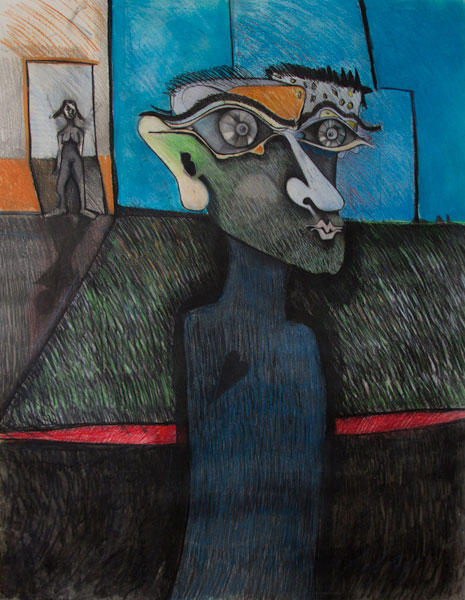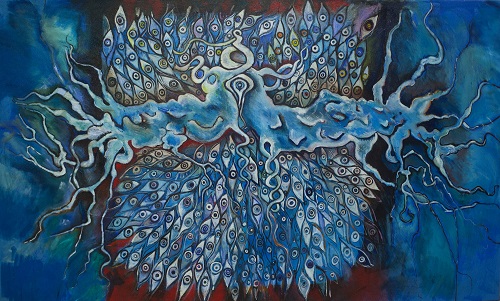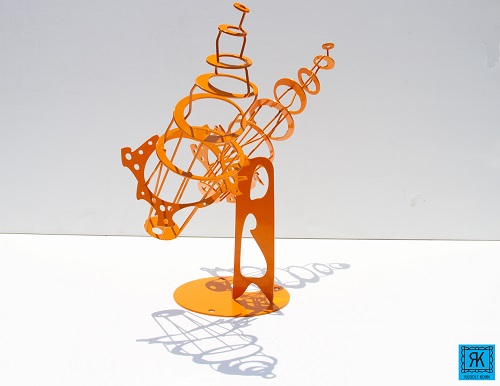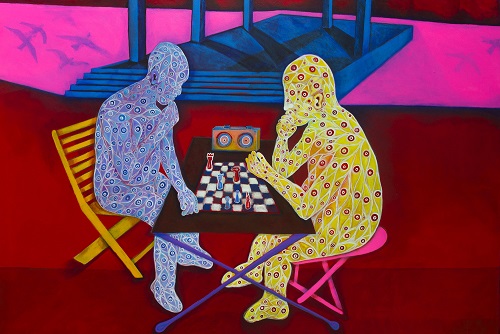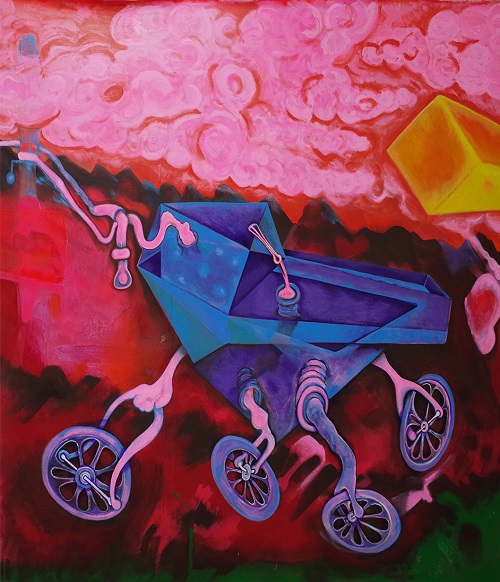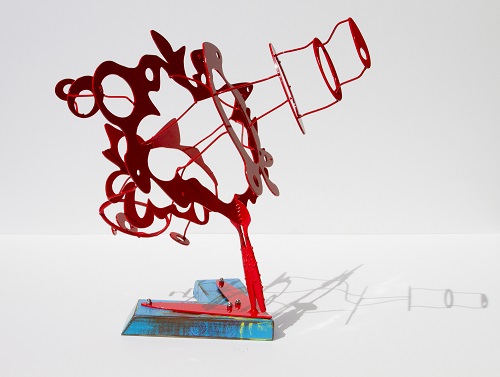Rudolf Kohn: Desmitificar a través del arte
La herencia expresionista en el arte ha marcado significativamente la visión del hombre y la cotidianidad desde finales del siglo pasado. El acto liberador que confiere al color y la forma una autonomía plástica sin precedentes es el complemento expresivo de una temática muy centrada en lo social y en la problematicidad de la existencia. La angustia, la incomunicación, la alienación y la desacralización de los mitos de la modernidad y el progreso son algunos motivos que inspiraron la rebelión expresionista. La poética expresionista, de diferentes modos, está conectada con el arte primitivo, con las formas populares de representación e incluso con el arte de los niños porque es aquí donde encuentra una fuente “incontaminada” de expresión desde la cual dar rienda suelta a las emociones y explorar las vivencias interiores más reveladoras. Quizás esto explique el carácter autobiográfico de la obra de muchos expresionistas o, al menos, la presencia activa de la vivencia personal en la selección temática.
La pintura de Rudolf Kohn es intensa y dramática pero matizada por una fina dosis de humor y una gran ironía. El modo en que asume los códigos expresionistas parecen reflejar la peculiar simbiosis cultural de su origen: hijo de padre alemán y madre colombiana. En su obra se combinan la racionalidad y precisión en el dibujo con la exaltada fantasía y la magia de quien ha vivido lo insólito como un hecho cotidiano. La sensibilidad crítica de este artista toca con igual dosis de cuestionamiento aspectos de la realidad social que van desde una especie de costumbrismo caribeño hasta los grandes tópicos de la enajenación y el desconcierto existencial. Los temas de la violencia, el machismo, la mecanización de la vida humana y la muerte misma están representados con esa agudeza peculiar de quien observa la realidad con una mezcla de implicación y distancia.
En buena parte de la obra de Kohn hay una fuerte presencia del elemento gráfico que unido a la caricaturización de sus personajes y al uso explosivo del color conforma una imagen muy próxima al diseño de carteles y a la ilustración tal y como fueron reformulados por el Pop Art. Y este es un dato interesante porque contrasta con otro tipo de pintura más barroca e informalista del propio artista en donde la mancha de color, el rayado del lienzo, el chorreado del óleo y la concepción general de la composición proponen una mirada más angustiante sobre el hombre en lo que parece ser un homenaje permanente a “El Grito”, de Edward Munch. En realidad, Kohn es un artista cuyas motivaciones estéticas y sociales se mueven en un amplio abanico de tonos, acentos y símbolos que pese a sus diferencias siempre giran alrededor de una percepción crítica y desmitificante de la cultura actual. Mas que rostros posibles, sus personajes parecen un alter ego revelado en forma de máscara y simulacro; sin embargo, a veces asoma un cierto lirismo compasivo que es el otro costado de la ironía.
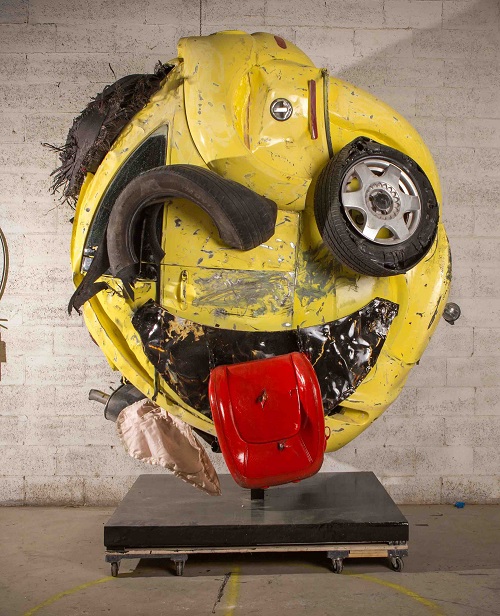
Por eso sus escenas pueden llegar a lo grotesco o, por el contrario, dar una imagen en la que las figuras muestran un desamparo sobrecogedor, en ambientes deshumanizados donde todo- hasta una flor- parece artificial. De algún modo, la situación ironizada conmueve al artista y eso se refleja en su grado de compromiso con el tema, en su identificación con esos seres transmutados por su imaginación en símbolos de la condición humana. Pero no sólo en los temas y en su tratamiento plástico hay heterodoxia; Kohn es un artista que no conoce fronteras y que apela a cualquier recurso expresivo en el intento de comunicarnos no una anécdota particular sino un hecho artístico. Desde sus trabajos iniciales la experimentación con técnicas, medios y soportes no convencionales evidenció su necesidad de encontrar significantes que trasmitieran la idea artística con más fuerza y originalidad. El estuco, la madera, el saco de yut, los collages o las cajas de madera con objetos personales o efectos pictóricos son algunas alternativas con las que el artista quiso mostrar el valor semántico del material y el soporte.
Si la presencia de ruedas, poleas de transmisión y otros dispositivos mecánicos articulando el organismo humano es un modo directo de representar la sustitución del alma o lo espiritual por la tecnología – imagen característica de la serie “Bicharros”-, el otro símbolo constante en la obra de Kohn es el ojo trascendental y omnipresente. El ojo- según el propio artista- es la encarnación terrena de la presencia de Dios y la muestra de que no todo está perdido. Finalmente, la pintura de Kohn es también una exploración en esos contrastes entre la autenticidad y la alienación, entre lo humano y lo divino entre la trascendencia y lo cotidiano. Y por ese camino de búsquedas ha ido conquistando un lenguaje de originales códigos que logra tener en el espectador más impacto emotivo que la propia realidad que nos revelan.
Rudolf Kohn: Demystifying through Art
Arts expressionistic patrimony has significantly marked mans vision and everyday life since the latter part of the 19th Century. The liberating act conferred an unprecedented plastic autonomy to color and shape is the expressive complement of a thematic that’s very much centered on society and the problems of existence. Anguish, lack of communication, alienation and desecration of myths about modern life and progress are among the motives that inspired the expressionist rebellion.
![]()
Expressionistic poetry is linked in different ways to primitive art, popular representation forms and even children’s art because its there where an “uncontaminated” source of expression can be found, where emotions and the exploration of the most revealing interior experiences are given free reign. Perhaps that explains the autobiographical aspects of the works of many expressionists, or at least, the active presence of personal experiences in thematic selection. Rudolf Kohn’s paintings are intense and dramatic but with fine touches of humor and great irony.
The way in which he adopts expressionist codes seems to reflect his origins peculiar cultural symbiosis: son of a German father and Colombian mother. His works combine rationality with precision in the drawing of exalted fantasies and the magic of someone who has lived the uncommon as part of daily life. This artist’s critical sensibility touches with equal questioning dosages on aspects of society’s realities, which range from a sort of an expression of Caribbean regional customs to the big subjects of alienation and existential perplexity. The subjects of violence, machismo, the mechanization of human life and death itself are represented with the peculiar sharpness of someone who observes reality with a mix of involvement and distance. In much of Kohn’s works there is a strong presence of graphic elements that along with the caricaturization of its characters and the explosive use of color make up images that are very similar to the way in which signs and illustration were reformulated by Pop Art.
This is an interesting fact because it contrasts with the actual artists other types of more Baroque and informal painting, in which color stains, canvas scratches, oil drips and the general conception of composition propose a more distressful look at man in what seems to be a permanent homage to Edward Munch “The Scream.” In fact, Kohn is an artist whose aesthetical and social motives come in a broad fan of different tones, accents and symbols that, despite their differences, always have to do with a critical and demystifying look at today’s culture. More than likely faces, his characters seem to be an alter ego that is revealed as a mask and simulacrum; however, a sort of compassionate lyricism peeks out sometimes, which is irony’s other aspect. That’s why his scenes may come to be grotesque or, on the contrary, project an image in which figures show an overwhelming abandonment in dehumanized atmosphere where everything even a flower seems artificial. Somehow, the ionized situation moves the artist and that is reflect in his level of commitment to this subject, in how he identifies himself with those beings transmuted by his imagination into symbols of the human condition. What’s heterodox is not only found in the subject matter or in his treatment of plastic; Kohn is an artist who knows no boundaries and who resorts to any expressive recourse as he tries to communicate to us not a particular anecdote but an artistic event.
Ever since his first works, the experimentation with techniques, media and unconventional props showed the need to find symbols that transmitted an artistic idea powerfully and originally. Stucco, wood, jute sacks, collages or wooden boxes with personal objects or pictorial effects are among the alternatives the artists chose to show the semantic value of materials and props. If the presence of wheels, transmission pulleys and other mechanical devices that articulate the human body is a direct way of representation the substitution of the soul or the spiritual by technology an image that’s characteristic of the “Bicharros” series-, the other constant symbol in Kohn’s works is the transcendental and omnipresent eye. The eye- according to the artist himself- is the earthly incarnation of Gods presence and shows that that everything is lost. Finally, Kohn’s painting is also an exploration of those contrasts between authenticity and alienation, between what’s human and divine, between what’s transcendental and daily. And along that path of searches he has conquered the language of original codes that manage to have a more emotional impact on spectators than the reality itself that they reveal.
© All rights reserved for text Jorge de la Fuente
Rudolf Kohn was born in Bogota, Colombia in 1971. He began his first drawings at age 3 and his first apprenticeship with David Manzur at age 13. Then went on to completing his degree in Fine Art at Universidad de los Andes (1992), simultaneously, apprenticing with Augusto Ardila. Rudolf’s first professional exposition was at age 18.
His paintings are alive as satirical anecdotes, illustrating history past and that is yet to come. Rudolf has several themed series that mark his style, Vicharros (2002), Ozotron (2006), City of Love (2009), Guerreros del Espacio (Spiritual Warriors) (2010), and Made in China (2013). He is currently working with a new series “Nature and the Machine.” Most works are large format oil or acrylic on canvas, or drawings on paper. His sculptures explore the third dimension. Using stainless steel and aluminum, he displays layers of concentric forms that relate to the interconnected thread of life.
Rudolf arrived in Miami, Florida in 1992 beginning as an artist resident at the Bakehouse Art Complex (BAC). He participated in group and solo exhibitions for BAC. From 1992-2015 Rudolf has been widely recognized and exhibited in Florida, New Jersey, New York, New Mexico, San Francisco (McLoughlin Gallery), Mexico, Puerto Rico, and Colombia (La Pared Gallery). Kohn has artwork in private collections in US, Europe, Colombia, England, Brazil and Dubai. In Miami, Rudolf has several paintings and sculptures displayed in the Miami Private Art Collection. He was recently (2016) commissioned for a large public art sculpture titled, ‘The Last Emoji’ for Sprint. In late 2015 Rudolf participated in an exhibition by The Museum of Contemporary Art exhibited at the Miami Country Day School. In 2014 and 2015 Rudolf exhibited paintings for Artcycle at the Coral Gables Museum of Art and at Seafair in 2014. Rudolf served as Executive Director, Curator, and featured artist for Burst Art Fair during Art Basel Week 2011. He also curatored Alta Temperatura at Mcloughlin Gallery in San Francisco, CA
Rudolf Kohn
artekohn@gmail.com
Artopia 2017

